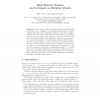Free Online Productivity Tools
i2Speak
i2Symbol
i2OCR
iTex2Img
iWeb2Print
iWeb2Shot
i2Type
iPdf2Split
iPdf2Merge
i2Bopomofo
i2Arabic
i2Style
i2Image
i2PDF
iLatex2Rtf
Sci2ools
EUROCRYPT
2004
Springer
2004
Springer
Hash Function Balance and Its Impact on Birthday Attacks
Textbooks tell us that a birthday attack on a hash function h with range size r requires r1/2 trials (hash computations) to find a collision. But this is quite misleading, being true only if h is regular, meaning all points in the range have the same number of pre-images under h; if h is not regular, fewer trials may be required. But how much fewer? This paper addresses this question by introducing a measure of the “amount of regularity” of a hash function that we call its balance, and then providing estimates of the success-rate of the birthday attack, and the expected number of trials to find a collision, as a function of the balance of the hash function being attacked. In particular, we will see that the number of trials can be significantly less than r1/2 for hash functions of low balance. This leads us to examine popular design principles, such as the MD (Merkle-Damg˚ard) transform, from the point of view of balance preservation, and to mount experiments to determine the b...
| Added | 01 Jul 2010 |
| Updated | 01 Jul 2010 |
| Type | Conference |
| Year | 2004 |
| Where | EUROCRYPT |
| Authors | Mihir Bellare, Tadayoshi Kohno |
Comments (0)

